Lincoln in Lincoln Park
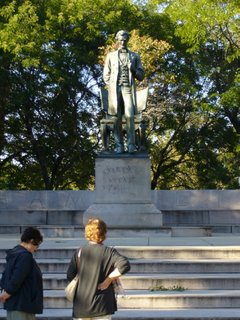
Giving the podium back to Loredo Taft -- here is what he had to write about the statue of Lincoln in Chicago's Lincoln Park -- from "Modern Tendencies in Sculpture" published in 1921. By the way -- only two artists got their own chapters in this survey: Augustus Rodin and Augustus Saint-Gaudens.
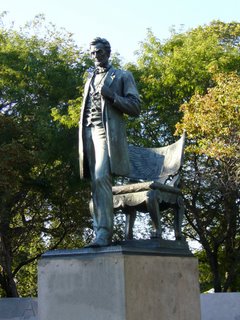
On the afternoon of a beautiful day in May, 1881, the "Farragut”, erected upon its admirably designed exedra, was unveiled in Madison Square and made public property. From that time Saint-Gaudens held securely the leadership of American sculpture. Yes, from that day our national art has been colored by his dominant influence.
I like Kenyon Cox's description of the "Farragut": "There is no cold conventionalism, neither is there any romanticism or melodrama, but a penetrating imagination which has got at the heart of the man' and given him to us 'in his habit as he lived,' cool, ready, determined, standing firmly, feet apart, upon his swaying deck, a sailor, a gentleman, and a hero."
Such perfection of workmanship was a novelty and a revelation to America. Here were all the plastic "color" and fluency of modern French handling within a severely simple contour. The two qualities are indispensable to great sculpture, and in this figure they are happily combined. Saint-Gaudens never did a finer piece of work.
In 1885 the sculptor’s notable high relief of Dr. Henry Bellows made more widely known his ability in portraiture and particularly his unique decorative sense. In this remarkable work he seems to establish more firmly than ever his relationship with the fascinating Florentines of the fifteenth century.
The year 1887 was marked by a great event, not only in the life of the sculptor but in the history of American art. It was in that year that the "Abraham Lincoln" was unveiled in Lincoln Park, Chicago. This product of profound study and unwearying experiment instantly justified all of the toil which the master had lavished upon it. In regard to its reception I may be permitted to quote a paragraph or two from my History of American Sculpture:
"The 'Lincoln” was at once hailed as the greatest portrait in the United States. It has remained so. From its exalted conception of the man to the last detail of its simple accessories it is a masterpiece. The sculptor's idea was a novel one, which may have been suggested by Mr. Yolk's 'Lincoln' at Springfield, Illinois. He introduces the striking adjunct of a large chair, from which the President is supposed to have risen. Before it stands the gaunt figure with bowed head, as though lost in thought, or preparing to address a multitude. The left foot is well advanced; the left hand grasps the lapel of the coat in a familiar gesture. The right is behind the back, affording an agreeable but inconspicuous counterbalance to the droop of the head. It has been pointed out that the bent left arm gives interest to the lengthy front and at the same time suggests an arrested movement of the hand to the brow, thus reinforcing the idea of concentration of mind. "But it is the expression of that strange, almost grotesquely plain, yet beautiful face, crowned with tumbled locks, which arrests and holds the gaze. In it is revealed the massive but many-sided personality of Lincoln with a concreteness and a serene adequacy which has discredited all other attempts and, indeed, with the 'Admiral Farragut,' has 'brought about a new scale of values' in our portrait art. It has been Saint-Gaudens' rare talent to give life without realism, to offer us 'a suggestion of reality shrouded in poetry and grace.' For even this gnarled form has a grace all its own-the 'inward grace' which a profound master has apprehended and made visible."
I remember what a surprise that empty chair gave us. It was so daring-so strange! One had only to imagine it eliminated, however, to realize promptly how essential it was in the composition. Seen from a distance the figure without it would show but a meager and attenuated mass. Reinforced by this accessory the silhouette becomes ample, monumental. One approaches near enough to study detail, to read the expression, and the chair seems to disappear; it has served its purpose and now falls discreetly out of focus. It is one of the most ingenious devices of modern monumental art. All such considerations are forgotten, however, when one comes under the spell of the noble presentment. The bowed head and the broad shoulders-that combination of tenderness and strength which is the greatest thing possible in art, as indeed it is in life--are the introduction to a completeness of expression appealing to every heart. Royal Cortissoz has well summed up the power of our greatest sculptor when he says: "It is not simply that each one of the monuments has certain specific artistic" merits, lifting it to a high plane. It is rather that in everyone of his studies of historical subjects, Saint- Gaudens has somehow struck the one definitive note, has made his Lincoln or his Sherman a type which the generations must revere and which no future statues can invalidate.
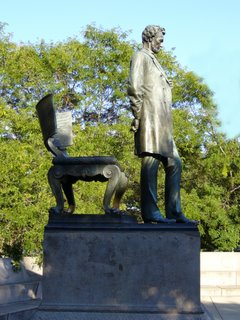

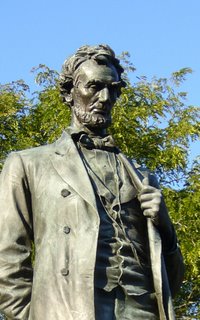



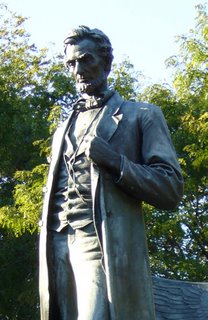
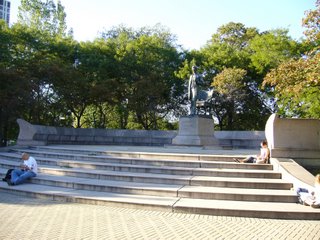



7 Comments:
Hi Chris, is it okay if I take the Saint-Gaudens as a starting point to run an idea by you? I stumbled across a site on Giacometti the other day. Not an artist who I thought I had much sympathy with. But I was looking at this abstract work[1] of a husband and wife couple and thought it unexpected proof for an idea I've been toying with: the 'glyphic'. (No doubt an idea I've unknowingly nicked from someone else!)
I've been wanting a term to describe an artist's ability to give form to things. I don't mean plastic rhythm, per se, but intelligible, meaningful, organised form. That gift artists have in degrees to make something understandable or cognizable even if it doesn't strictly follow natural appearance.
And so 'glyphic' seemed the natural term, with suggestions of the Egyptian hieroglyphic picture-word. Although ideogram would be the more accurate term, I guess.
There's not much point to this ramble, I'm afraid, as I just wanted to run this concept by you. The idea that the power of giving 'intelligible and definitive form' to an object, idea, etc., is one of the primal sources of artistic expression, and that is something we find almost universally in savage, primitive, naive, or mystical art. Hence my initial reference to the Giacommetti: although this monument shuns the subtle rhythms of nature, it achieves an abstract or archetypal glyphic condensation of the concept into a block of stone. My point isn't to argue that all abstract work is good, but to offer the concept of the 'glyphic' as a criterion for measuring which abstract works (like the Giacometti) are intelligible, and which are feebly geometric or (worse) shapeless and inarticulate.
Anyway, those are my jumbled thoughts, and I was wondering if you've ever thought along similar lines, and if you would be interested in taking this line of thinking further ...
regards,
Iian Neill
[1] http://www.artchive.com/graphics/couple.jpg
I'm very glad you're here Iian -- and I'm glad you're taking up the issue that Taft raised concerning the above statue: "to give life without realism, to offer us 'a suggestion of reality shrouded in poetry and grace."
Taft raised the same issue in his survey of French 19th C. sculpture in my previous post -- citing Carpeaux as a bad example (though a good sculptor) for the legions of naturalists who followed him.
But I'd like to narrow our concern from whether a work is intelligible -- to a tiny subset of such things --- i.e. those that are worth seeing. Lot's of things -- like the Giacometti -- or toy soldiers -- are intelligible -- but when are they "a type which the generations must revere and which no future statues can invalidate."?
I think that a word like "symphonic" might be more relevant here than "glyphic" -- indeed, I think much of the language applied to music is relevant here as well -- with words like "rhythm" and "melody"
These words point to qualities that I think are sorely missing from the re-birth of figurative art --- in both painting and sculpture -- where anatomy is (regretfully) accepted as the basic knowledge that is fundamental to good figure sculpture.
I want your thoughts on the essentials for good figurative sculpture...heck, GREAT figurative work...(I am currently in a school that supports the anatomy angle...kindly remind me that there is another world out there...)!
The essentials of great figure sculpture ? What a fine question to contemplate this rainy October night in Forest Park, Illinois.
The word "scale" is the first one that comes to mind --- I guess because that's the one quality that is most glaringly absent from those stiff, shriveled, pinched disasters of post-1950 figure sculpture - including the recent superstars, Richard McDonald and Frederick Hart.
It's the quality that makes something feel big -- regardless of its actual size -- and results from how the whole piece measures the space around it.
I'd call it basic --- but it's not like you learn it and then you're done --- it's more like something that is always aimed at -- and sometimes achieved.
So it can't be easily taught and learned -- like anatomical structures -- and this is what everyone needs to understand about all the arts (not just sculpture): art education in our society is a much more significant economic event than the practice of art itself -- and things that make for a successful teaching program -- do not necessarily have anything to do with the art that is supposedly being taught.
So I guess the bad news is that currenty it has to be self-taught --- but the good news is -- that there are so many accessible examples of success -- especially in Florence Italy.
When your classes are finally over -- you might even consider staying in Florence -- and letting Donatello and Ghiberti be your instructors.
They were my instructors in 2001 and 2003, including Bernini and Michelangelo. No living man or woman guides this heart, hand, and mind when they are operating in combination.
I do not desire to return to America...how interesting that you touch on this sentiment.
I rarely drink, and when I do in the company of friends, it is a mere tablespoon or so. A bit of limoncello was going in as I read of "those stiff, shriveled, pinched disasters..." -- it was painful -- very, very painful -- more so than the inhalation of Diet Coke when laughing. We have a word for this inhalation of liquid in the midst of intense emotion: spoozle. A lovely verb, no? To spoozle. I spoozled.
I have much to expound upon in the realm of art instruction from the vantage of both instructor and student, of what might contribute to success and of the many detractors from that goal...but Internet is bloody expensive here...
Via Google, I found myself in the pleasant realm of those discussing snails. If you or anyone else of a like mind should have an interest in letters from Italy, do let me know. I would greatly look forward to some semblance of intelligent, two-way discourse on these subjects.
I only wish I had more time to think this all through better but here is a ramble on one of your posts and comments. I think I will put it on my Dorset Blog to save clogging up yours unless you want me to.
I am intrigued by your conversation with Lian Neill.
First of all the understanding of your comment (in italics);
………Rhythm and Melody………..
These words point to qualities that I think are sorely missing from the re-birth of figurative art --- in both painting and sculpture -- where anatomy is (regretfully) accepted as the basic knowledge that is fundamental to good figure sculpture.
There is the meaning 1. figuratively speaking…and
2. figurative, as in the realistic human figure…….
In the flow of your conversation, “abstract”, in the meaning associated with Giacometti’s “couple”, might be closer to figuratively speaking than to, figurative as in the (realistic) human figure!
An individual sculptor is going to have a style of his own and mixed with his mistakes (recognised or not, by the viewer; himself included) will add to the degree of abstraction in the work. Matisse’s works below illustrate my meaning.
Liam is I think talking about symbolism when he refers to hieroglyphics. Matisse’s 4th work here is almost a Hieroglyphic where the first is a more complex form. Comparing the general understanding of what was meant by “Art” in 1880 from that of 1980 I believe in the concept that only time will judge a work and only a very few works will always be in “fashion”.
My view, for what it is worth, is expressed below and published in 1919, 2 years after this urinal was being created and exhibited as “Art” in New York.
The book from which this following line is taken is roughly based on Gauguin’s life;
…art is a manifestation of emotion, and emotion speaks a language that all may understand… I cannot agree with the artists who claim superciliously that the layman can understand nothing of Art, and that he can best show his appreciation of their works by silence and a cheque-book. (W. Somerset Maugham, The Moon and sixpence, edition 10 (Vintage, London, 1999) pp.2.)
Musical terms such as Rhythm and Melody have made me think about my own work and whether they have such attributes! This has made me think about what Rhythm and Melody mean in terms of metal or stone (or other solid material).
Rhythm ~Symmetry and Regularity, Beat, Flow, Proportion, Time, Repetition, Pulsating sound or feeling often pleasing to the senses and fundamental to the art form of “Dance” .
Melody ~ Sequence of agreeable musical sounds or notes, Air, Tune, Sweet sounds agreeable to the ear as in; babbling brook or whispering sounds of the wind in the trees etc. (Melody often has rhythm too).
The important theme in both is “Pleasing and agreeable”. Never in a month of Sundays would I describe the urinal thus, except in relief of finding one when urgently needed!
Sometimes I think it is better to just let it flow and not think too much about such high literary concepts. Better get on and do some work or we will starve!
Thanking, again, everyone for all of these intelligent responses to my worthless blog.
To Amanda, I'm glad you got spoozled by my attack on the recent stars of American figure sculpture.
(I assume that's an enjoyable experience)
What middle-brow people like to collect is as irrelevant to me as what their high-brow cousins are donating to museums of contemporary art.
Anyone who has eyes -- and been to places like Florence -- knows the top of the barrel from the bottom.
To Robert: By "melody" I really mean "catchy tune" -- the thing that's so exciting -- and memorable -- about all the music I like -- whether it's Mozart or Cole Porter.
It's that certain something that makes me want to hear a song -- or
see a statue --over and over again.
Regarding the Maugham quotation -- I guess that the last 50 years of "art theory" have made me suspicious of any sentance that begins with "art is....."
I don't care about what "art is" -- I care about the things I like -- and while that does require someone to practice whatever art it takes to make them -- that's usually their business,not mine.
Post a Comment
<< Home